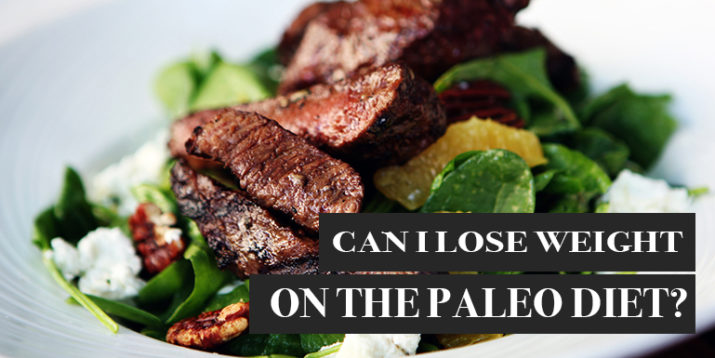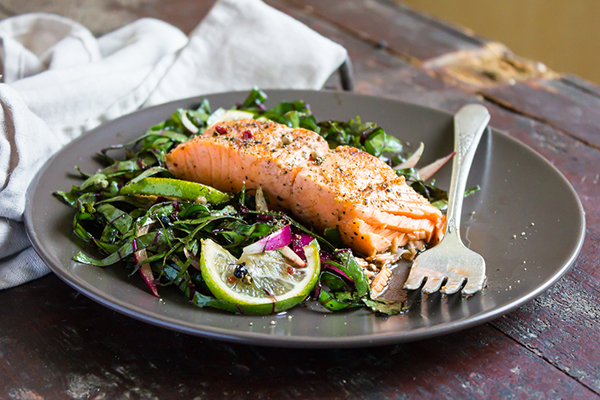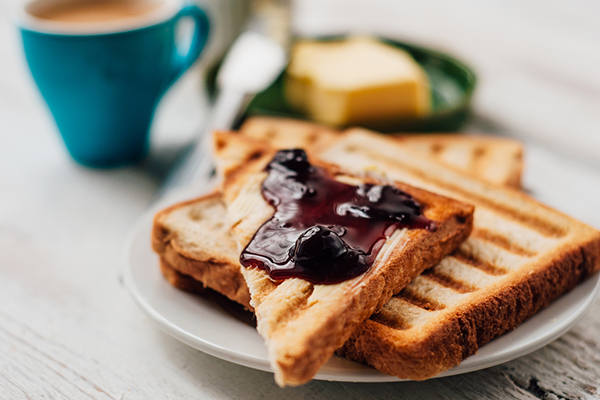Can I Lose Weight on the Paleo Diet?

Whether you’re considering a Paleo diet to cut out processed foods, to eliminate certain food groups associated with your dietary intolerances, or to lose weight, there’s no denying that this caveman-inspired approach to eating is hugely popular.
The premise of the Paleo diet is to eat the same foods our pre-agricultural hunter-gatherer ancestors presumably ate: fruits, vegetables, meat, seafood, and nuts. Of course, no one was keeping food diaries back then, so there’s debate about exactly which foods are considered “Paleo” or not.
But on the whole, Paleo followers believe a grain-free, dairy-free diet more closely aligns with how humans genetically evolved to eat food.
The weight loss and health benefits of going Paleo are still up in the air, with only a handful of very small studies published on the topic. Regardless, a lot of people seem to be giving up grains and doing without dairy these days. Let’s take a closer look at what all the fuss is about.

What Can You Eat on a Paleo Diet?
In short, the Paleo diet says whole foods are in, processed foods are out. Paleo-approved foods include:
- Vegetables: Lots of them — particularly non-starchy ones like broccoli, spinach, kale, cauliflower, tomatoes, and zucchini. Moderate amounts of starchy vegetables, like sweet potatoes, yams, and squash, which are all great sources of nutrient-rich carbohydrates, are allowed.
- Fruits: In moderation. Berries are popular since they’re lower in sugar, higher in fiber, but all fruits are OK, including dried — as long as they don’t contain added sugar.
- Meat: Preferably local, pasture-raised beef, poultry, and pork.
- Eggs: Again, preferably from local, pastured chickens, quail, and other birds.
- Fish and shellfish: Wild-caught, high in omega-3 fats, and low in mercury.
- Minimally processed fats and oils: Walnut, avocado, coconut, and extra virgin olive oil, plus coconut milk, as well as animal-derived fats like lard and tallow.
- Nuts and seeds: Macadamias, almonds, walnuts, cashews, sesame seeds, and flaxseeds. (Homemade nut milks are Paleo-friendly, too.)
- Natural sweeteners: In moderation, including honey, maple syrup, and coconut sugar.

What Can’t You Eat on a Paleo Diet?
Anything processed or packaged is out as a general rule, though more and more Paleo-friendly convenience foods are popping up in supermarkets. On the no-go list:
- Grains and legumes: Wheat, barley, rye, corn, oats, brown rice, soy (including soybeans, tofu, and any foods that contain soy-derived additives), peanuts, beans, and lentils.
- Highly processed fats: Vegetable, canola, palm, safflower, sunflower, and soybean oils, as well as margarine.
- Dairy products: Cheese, milk, yogurt, kefir, cottage cheese, and butter.
- Foods with added sugars: Particularly soda, sweets, and packaged foods. Fruit juice, a concentrated source of sugar, is off-limits, too.
- Most forms of alcohol: Including beer and liquor, though many Paleo adherents say red wine and hard cider are OK.
How Can a Paleo Diet Help You Lose Weight?
With grains, legumes, and refined sugars out, a traditional Paleo diet is typically higher in protein, fiber, and fat and lower in high-glycemic carbohydrates.
A study from Emory University suggests that our Paleolithic ancestors consumed approximately 30 percent of calories from protein, 35 percent from carbohydrates, and 35 percent from fats. Honey is thought to have contributed about three percent of total calories, while their fiber consumption was around 100 grams per day.
Contrast this to the typical modern American diet, which is approximately 15 percent protein, 50 percent carbohydrates, and 35 percent fat, with the nearly 15 percent of calories coming from added sugars. In terms of fiber, today the average adult only gets about 15 to 18 grams of the recommended 25 to 30 grams of fiber daily.
Compositionally speaking, the Paleo diet is geared toward weight loss: It’s higher in protein, fiber, and fat, which keep hunger at bay and blood sugar levels in check. The extra protein offers muscle-sparing benefits when the body is burning anything and everything it can for energy, which helps blunt the reduction in metabolism that commonly accompanies weight loss.
And let’s not overlook the significant reduction in high-glycemic carbohydrates: Cutting out refined grains and most added sugars eliminates two top sources of empty calories that raise your body’s level of insulin, our primary energy-storage hormone.
How Much Weight Can You Lose on a Paleo Diet?
So just how much weight can you lose on the Paleo diet? The truth is, as with all diets, it depends. Age, gender, current weight, metabolic rate, body composition, diet, and activity level all factor into the weight-loss equation.
Generally speaking though, it’s reasonable to expect a loss of one-quarter to two pounds per week (or one to eight pounds per month), depending on the variables mentioned above.
Why You’re Not Losing Weight on a Paleo Diet
But cutting out soda and cheese isn’t a guarantee you’ll lose weight. Why? Because consuming too many calories — whether from soda or naturally sweetened, grain-free treats — will lead to weight gain.
Just because you’re not counting calories on this diet doesn’t mean they don’t count. Regardless of the type of nutrition plan you follow, you should still focus on portion control.
If you’re following a Paleo diet and haven’t lost weight, or you haven’t seen the scale budge in more than a couple of weeks, try some of these tweaks to kick-start the process:
- Re-assess your sugar intake: Sugars, even those naturally present in whole foods, contain calories and can stall weight loss when over-consumed. Make sure you’re not overdoing it with fruit (both dried and fresh) or natural sweeteners like the coconut sugar, honey, and maple syrup commonly found in grain-free Paleo treats.
- Go easy on the starches: If your Paleo prescription includes starchy veggies, remember to eat them in moderation. Similarly to sugars, they’re digested relatively quickly and have a greater impact on blood sugar and insulin than other foods on the Paleo diet.
- Portion out seeds, nuts, and nut butters. Nuts, by nature, are high in fats, which contain more than double the calories per gram than carbohydrates or protein. But they’re also highly snackable, it can be easy to lose track of portions. If you eat a lot of nuts, trail mix, or nut butters, consider portioning these high-calorie foods into individual servings ahead of time.
- Eat non-starchy vegetables with every meal: Non-starchy vegetables are part of every weight-loss diet out there. Why? Because they’re naturally high in fiber and water and low in calories, meaning you feel fuller on fewer calories. They’re also packed with important vitamins, minerals, and phytochemicals.
Can a Paleo Diet Help Curb Cravings?
When you eat sugar often — and in large amounts — the brain’s response becomes blunted and your cravings may increase. If you’re a self-proclaimed sugar addict, eliminating refined sugars from your diet may decrease or eliminate your cravings for the sweet stuff over time. Sugar withdrawal symptoms usually last one to two weeks, after which cravings should subside.
However, if giving up refined sugar, grains, legumes, dairy, and French fries feels overly restrictive, this diet will most likely increase your cravings for these foods and probably won’t be sustainable in the long run.
6 Pro Tips for Going Paleo
So, you’ve decided to give this primitive diet a try. Here are a few tips for a smoother and more sustainable transition.
- Phase out one food group at a time: Rather than eliminating everything all at once, consider a step-by-step approach. So, start by cutting out refined sugars, then move on to dairy, grains, and legumes, one at a time.
- Plan and prep meals and snacks in advance: This diet can be hard to follow if you’re on the go or only have time for a quick bite. Having a Paleo-friendly meals and snacks at the ready will help you stick with it.
- Make sure you’re getting enough carbs: Cutting out grains and refined sugars will slash your carb intake, which can lead to headaches, shakiness, low energy, and reduced endurance levels. Starchy vegetables (sweet potatoes, squash, corn) and fruit are great alternative, Paleo-friendly sources of carbohydrates.
- Eat with balance in mind: Just because meat is high on the menu doesn’t mean our Paleolithic ancestors ate it night and day. Eat balanced meals that contain plenty of fresh vegetables and moderate amounts of meat, along with fish, fruit, and nuts.
- Sub in calcium-rich veggies: Since dairy and cheese are off the menu, make sure you get it from other sources like canned and fresh salmon, kale, and spinach.
- Don’t be afraid to modify: If you’ve struggled with restrictive diets in the past, a modified version of Paleo may be your best bet. Aim to include some whole grains and beans in your meals on occasion, or plan a couple of non-Paleo meals.
The Bottom Line
Can a Paleo diet help you lose weight? Absolutely. While it does exclude certain foods with nutritional value, like dairy, whole grains, and legumes, this approach does promote eating whole, unprocessed foods that contain a balance of protein, fat, fiber, and quality carbohydrates, and it cuts out all refined grains and most added sugars.
But research shows weight loss is possible on just about any eating plan, whether you cut carbs or fat, manage portions or macros, or count points. The key is sustainability — adopting a healthy eating way of eating that you can stick with for the long term.
